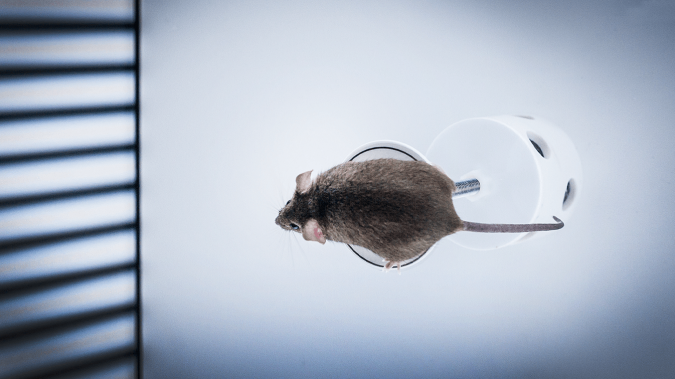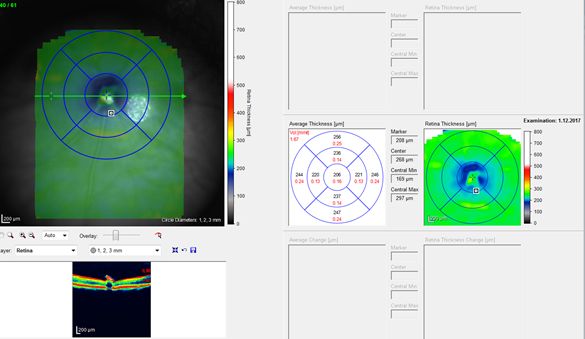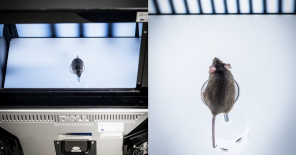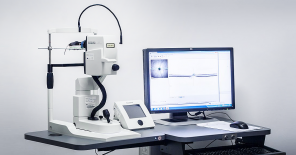
Vision
- Laboratory technician:
In special cases such as obvious morphological pathology of retina or special requests (e.g. mouse model for the retinopathy), the function of the retina is proved by electroretinography (ERG). Imaging devices with high image quality and resolution are used to examine the anterior segment (Pentacam) and retina (Optical coherent tomograph – OCT).
Standard services Optical Coherence Tomography
This non-invasive imaging procedure is used to examine the posterior part of the eye (retina and retinal blood vessels). An anaesthetised animal is placed on a platform and the spectral domain OCT, integrated with confocal scanning laser ophthalmoscopy (cSLO), is used to produce a detailed cross-sectional image of the retina and four retinal vascular plexuses (svc-superficial and dvc-deep vascular complex, choriocapillaris and choroid). This approach enables us to detect and analyze a wide range of mouse retinal pathologies, including changes in retinal thickness and layering, and in retinal vessel number or localisation. It is also possible to assess dynamic processes like edema formation, retinal degeneration and even microvascular pathology.
The AngioTool software is used to quantify variety of blood vessels parameters, e.g. blood vessel density, number of blood vessel junctions and end points per region.
Additionally the intraocular pressure (IOP) could be measured by the small transportable rebound tonometer IcareTonovet plus. This non-invasive and painless method give us important information about the eye function and health in the mice.
Representative images acquired by OCT-device (Heidelberg-Engineering).




Examples of visualization of vascular plexuses
Example of visualization of superficial (left images – svp) and deep (right images – dvp) vascular plexuses.
The figures 1 and 2 show a representative cross-section of the retina. The selected retinal layers are marked by red dash lines, yellow colour represents blood flow in the blood vessels.
The black and white images (fig. 3 and 4) represent original images whereas colourful images (fig. 5 and 6) show visual quantification of the two vascular complexes. Red lines within green ones represent blood vessels and blue points represent junction of the blood vessels.
Virtual Vision Test
This behaviour test provides a non-invasive functional analysis of visual performance in mice. The OptoMotry© system uses the tracking of optokinetic head and neck movements, that are reflexive in the mouse for the screening of functional vision. In this test, a mouse stands on an elevated platform in the epicenter of an arena surrounded by computer monitors, and a camera images the behavior of the animal from above. With the changing of threshold of spatial frequency, contrast, and motion of the grating, we are able to determine the visual acquity („clarity of vision“) of the tested animal. The advantage of this test is that animals with no previous exposure to the task can be tested and the measurements can be repeated regularly. This method can provide a powerful test of visual performance in gentically modified and pharmacologically treated mice.
Electroretinography
Electroretinography is a non-invasive diagnostic test that measures electrical responses of retina evoked by light stimulation. An anaesthetised animal is placed on a heated table inside a full-field stimulation globe (ganzfeld) and retinal responses are obtained using active electrodes placed on the cornea and reference and ground needle electrodes placed subcutaneously in the snout and at the animals’ back, respectively. The recorded signals obtained under various light conditions, stimulation intensities and timing protocols allow to individually assess the function of different retinal cell types, rods, cones, ON-bipolar cells, and, to some extend, also ganglion or amacrine cells. The standard stimulation protocols consist of single flashes of different intensity, slow (5 Hz) and fast (30 Hz) flicker and a long pulses in both dark-adapted (scotopic) and light-adapted (photopic) conditions. If needed, the protocols can be adapted to offer specific features, in example measurement of rod adaptation kinetics or stimulation by color light.
Do you have questions? Ask us
Custom services Histology
Standard histological staining with hematoxylin and eosin (H&E stain) can be performed on paraffin or frozen sections of embryonic or adult mouse eyes. This primary histological staining provides basic information about eye morphology.
Immunohistochemistry
Immunofluorescent (immunohistochemical) detection of specific lens and retina markers can be performed on paraffin or frozen sections of embryonic or adult mouse eyes. Analysis of specific lens or retinal markers can provide more detailed information about cell types present in these tissues and extend findings from H&E staining.
Do you have questions? Ask us
Vision unit was upgraded with the support from OP RDE project CZ.02.1.01/0.0/0.0/18_046/0015861 CCP Infrastructure Upgrade II









